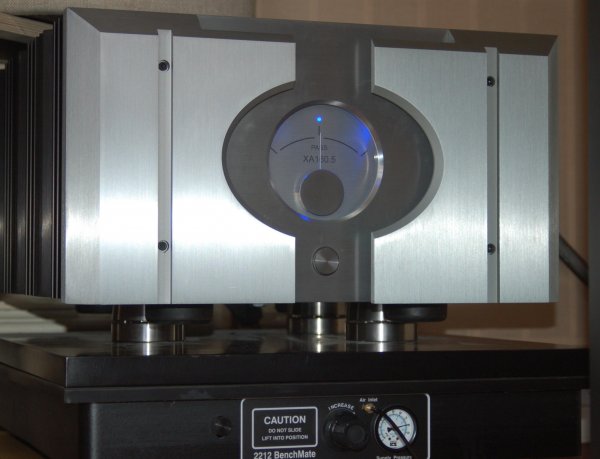
I have completed my trials with the Stillpoint Ultra 5s. I borrowed six units from an audio friend and placed three under each of my Pass Labs XA160.5 amplifiers. I oriented them with the beveled side up toward the bottom of the amps and the flat sides on my preloaded Vibraplane isolation platforms.
I’ve had them in my system for just over a week. The first time I heard them under my amps, I had them oriented the other way around and two toward the front near the transformer, and one near the back of each amp. My friend and I listened to four or five tracks with a variety of music. The results were mixed. My friend preferred the sound with the Stillpoints in place, but only slightly and I heard a little more clarity but also what I thought was a hardness to certain frequencies. We then removed them and listened again, and frankly, I was not sure if I preferred the system with or without them in place. He suggested that I keep them for a while and experiment some more.
I’m glad I took his advice. The next night, I put them back under my amps, but this time I reoriented them with the beveled side up and with two units towards the outside of each amp and one unit on the inside of each amp relative to the center of the room. This is because the amps are very heavy and space was tight on either side of my fireplace.
I also had to deflate the Vibraplanes as to not damage them with the shifting weight. Well, with this orientation, the sound was very different. I noticed an immediate improvement in overall clarity, detail and special information. I listened to a variety of music from small-scale jazz, to large symphonic music to solo drum, piano and voice. In every instance, the sound was better.
I then decided to deflate the Vibraplanes to try to isolate the contribution of the Stillpoints. The sound deteriorated. It became less clear, more congealed, less focused and more two dimensional. Bass also became slower, less extended and defined. This is consistent with what I noticed two years ago when I added the Vibraplanes to the system.
Someone suggested that I try the Stillpoints under one amp only and switch between channels while listening to a mono recording. I did that and frankly, with turning my head to face one speaker and then the next, it was a bit difficult to judge the sound. I heard very little if any difference, but then the sound was so different from having both speakers on with a center image, the whole experience was strange and unfamiliar. I suppose I could have moved the speakers to the center of the room and placed them right next to each other, and gotten a different result, but I was not willing to make the effort. I was also not willing to remove the Vibraplanes with their steel ballast plates and my amplifiers, a total of 420 lbs per channel, just to try the amps on the Stillpoints resting directly on the 200 year old uneven wooden floor boards.
The deflated Vibraplanes provided a very stable and solid platform or amp stand on which to try the Stillpoints. With the Vibraplanes deflated, the Stillpoints were an improvement over the stock rubber footers, but when I inflated the Vibraplanes the improvements reached another level. I understand that combining isolation devices may result in a compromised solution, but I found that the combination sounded better than either one did alone.
The experiments were fairly comprehensive and involved many combinations and types of music over eight days of listening. This is what I think is happening: the Vibraplanes are isolating the amps from floor borne and structural vibrations coming up from the house, the foundation and the suspended floor when it is excited by loud music. With the 136 lb steel ballast plates on top of the 150 lb Vibraplanes, these platforms offer a virtually vibration free surface on which to place the equipment.
Furthermore, the Stillpoint Ultra 5s seem to be drawing vibrational energy out of and down from the amplifiers. This energy is converted into head and dissipated. The result of this drainage and the lack of structural vibrations entering into the amps is an audio signal which is less corrupted by vibrations. The signal is cleaner.
The sonic result in my system is an increase in overall clarity and detail, a slightly more extended and articulate bass, improved soundstage information with a slight increase in depth and width. There is also more air and space around individual instruments which allows me to hear deeper into the recording.
Yesterday, I listened again to, and did a direct comparison between, the Pass XA160.5 and XA160.8 amplifiers at another friend’s house. I had heard these a few weeks ago, but there were other changes to the system, including Stillpoints under his Wilson Alexias. Interestingly, the differences between the two amplifiers can be summarized more or less as the difference in sound in my system with and with out the Stillpoints under my amps. Everything is clearer and more defined with the XA.8 amp compared to the XA.5 amp. I don’t think the difference is as pronounced with the Stillpoints in place as it is with the amplifiers, but it is significant, nonetheless.
I had tried these Ultra 5s under my Magico Mini 2 speakers about a month ago, but for various reasons, I did not like the result. My experience with them under my amplifiers is completely different. I can think of nothing they do that is detrimental and their addition clearly improves, in some significant ways, the overall sound of my system. I find them to be a very interesting product which can, in certain circumstances, really improve the sound of one’s system.


